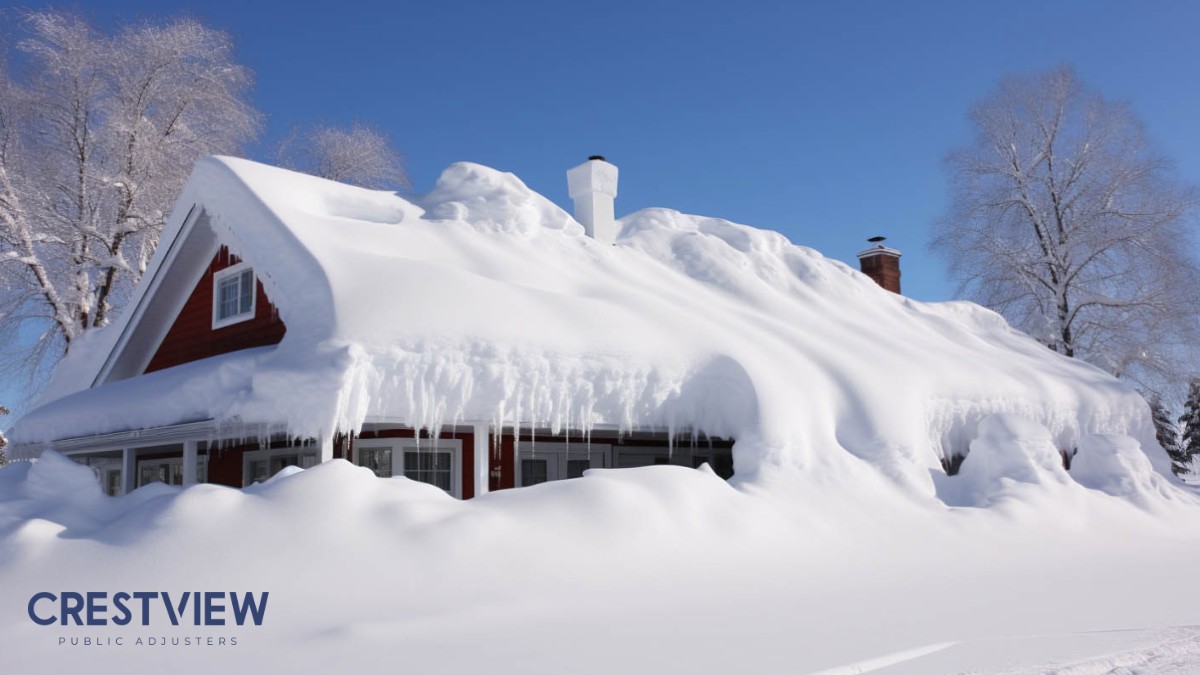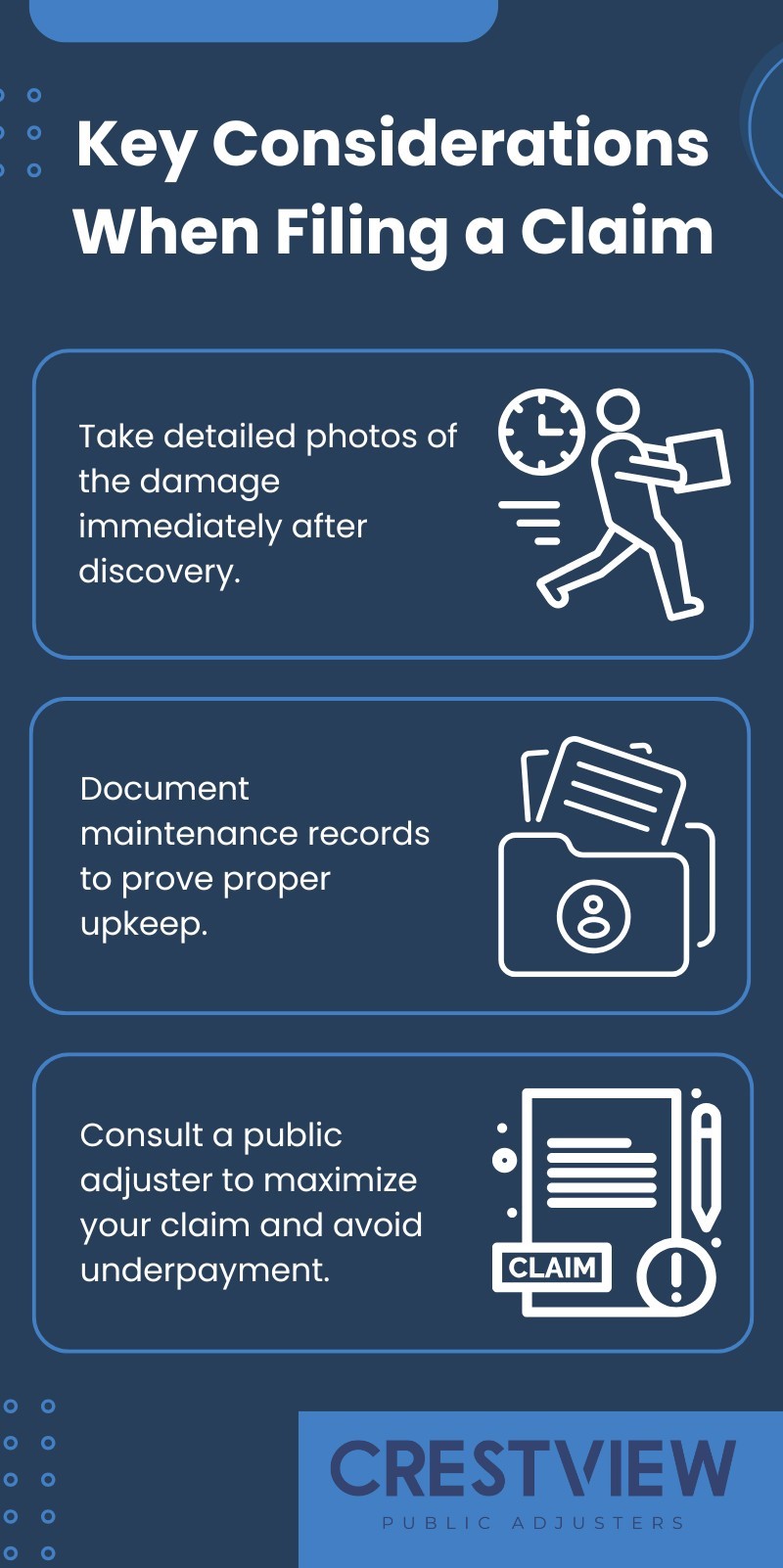Key Points:
- Heavy snowfall can compromise a roof’s integrity by adding significant weight and causing structural stress.
- Ice dams, freeze-thaw cycles, and prolonged snow accumulation contribute to severe roof damage.
- Policyholders should understand how to assess damage and navigate winter damage insurance claims effectively.
Heavy snowfall places extreme stress on roof structures, potentially leading to collapse, leaks, and structural weakening. Snow accumulation can add hundreds of pounds of weight, and when combined with ice dams and freeze-thaw cycles, it can cause long-term damage. Roofs with poor drainage or compromised structural integrity are particularly vulnerable. Understanding these risks is crucial for homeowners and business owners in snow-prone regions
The Weight of Snow: How Much Can Your Roof Handle?
One cubic foot of fresh snow weighs about 5–20 pounds, while packed or wet snow can exceed 20–30 pounds per cubic foot. Ice is even denser, weighing roughly 57 pounds per cubic foot. For context, a 1,500-square-foot roof covered in a foot of wet snow can bear over 30,000 pounds—a staggering weight for any structure.
- Flat roofs face the highest risk because snow accumulates evenly, creating intense pressure.
- Pitched roofs can shed snow more effectively, but improper insulation can lead to ice dam formation.
- Older buildings or those with pre-existing weaknesses are significantly more prone to structural failures.
Without proper snow removal, excessive weight can lead to sagging, cracked walls, and, in extreme cases, a full collapse.
Ice Dams: The Silent Roof Destroyers
Ice dams form when warm indoor air causes snow to melt and refreeze near the roof’s edges. Over time, these frozen ridges prevent proper drainage, leading to water infiltration under shingles, soffits, and even inside walls.
Consequences of Ice Dams:
- Roof Leaks: Water backs up under shingles, seeping into ceilings and insulation.
- Gutter Damage: The added weight can detach gutters or cause them to warp.
- Mold Growth: Persistent moisture encourages mold and mildew inside walls.
Proper insulation and ventilation are key to preventing ice dams, but once they form, removal should be handled carefully to avoid further damage.
Freeze-Thaw Cycles and Roof Longevity
Winter weather is unpredictable, with temperature swings causing snow to melt and refreeze repeatedly. This freeze-thaw process weakens roofing materials over time, creating cracks and gaps that allow moisture infiltration.
- Asphalt shingles become brittle and may crack, reducing their protective capabilities.
- Metal roofs expand and contract, potentially loosening fasteners and panels.
- Concrete or clay tiles can fracture under pressure, compromising the roof’s integrity.
Over time, these cycles accelerate roof deterioration, leading to costly repairs or premature replacement.
How to Identify Snow-Related Roof Damage
Detecting early warning signs can prevent a minor issue from turning into a disaster. Watch for:
- Sagging ceilings or bowing walls—indicating excessive roof stress.
- Cracking or creaking sounds—a potential sign of impending collapse.
- Leaks or water stains—suggesting ice dam damage or roof membrane failure.
If any of these symptoms appear, professional assessment and intervention are crucial.

Preventative Measures: Protecting Your Roof from Snow Damage
Homeowners and business owners can take proactive steps to minimize winter roof damage:
1. Regular Roof Inspections
Schedule pre-winter inspections to check for weak spots, deteriorating materials, or poor drainage. Addressing minor issues early can prevent major failures.
2. Snow Removal Strategies
- Use a roof rake to clear excess snow, especially after heavy storms.
- Hire professionals for large-scale snow removal to avoid damaging shingles or gutters.
- Never use salt or chemicals, as they can degrade roofing materials.
3. Improve Insulation and Ventilation
Proper insulation reduces heat loss, preventing ice dam formation. Ventilation ensures moisture escapes instead of condensing inside attic spaces.
4. Reinforce Structural Integrity
Older roofs may need extra support, such as adding bracing or upgrading to a higher snow-load capacity design.
Will Insurance Cover Snow-Related Roof Damage?
Most homeowners’ insurance policies cover sudden and accidental damage, such as roof collapse due to heavy snow. However, claims may be denied if the insurer determines neglect, lack of maintenance, or pre-existing structural weaknesses.

Navigating winter damage claims can be complex, and insurance companies often dispute liability.
Secure Maximum Compensation for Snow Damage Claims
Winter storms wreak havoc on your roof, making it challenging to secure a fair insurance payout. Crestview specializes in handling winter damage claims, ensuring policyholders receive the compensation they deserve.
If your home or business in New York, New Jersey, or Florida has suffered roof damage from snow, ice, or structural stress, don’t navigate the claims process alone. Contact Crestview today for expert public adjusting services and maximize your insurance settlement.

